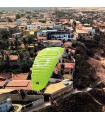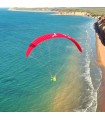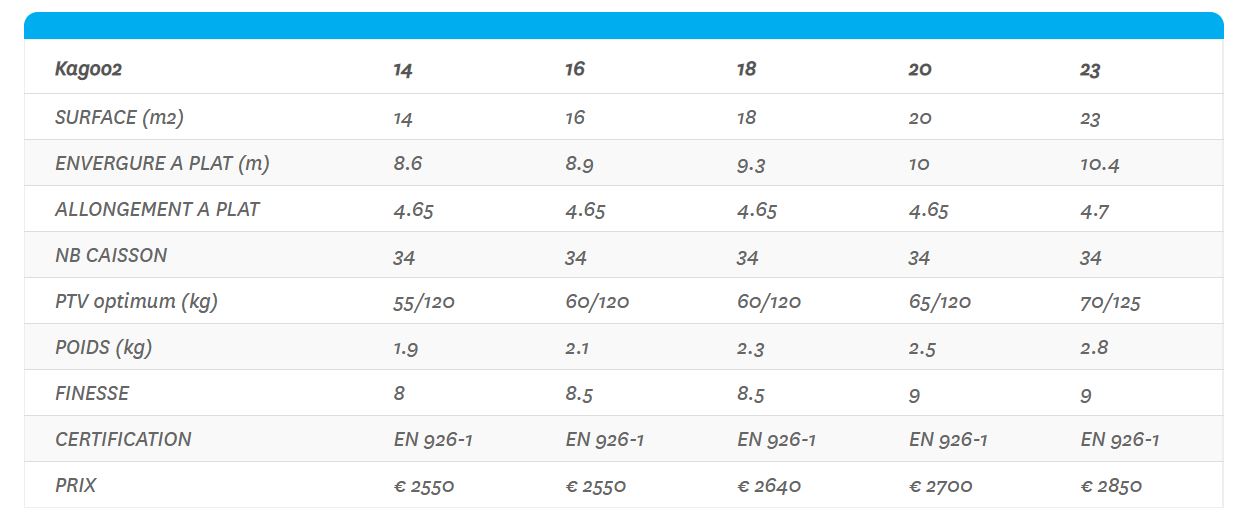A true hike-and-fly wing, but not the only one!
The Kagoo is aimed at pilots looking for a super-fun wing to enhance their mountain adventures. The level required to fly the Kagoo2 will depend on your wing loading, but you'll need a minimum of experience to fly safely.
Certification: EN 926-1
Sizes: 14 / 16 / 18 / 20 / 23
Surface area (m² ) : 14 / 16 / 18 / 20 / 23
Weight (Kg ) : 1.9 / 2.1 / 2.3 / 2.5 / 2.8
Takeoff Weight (Kg ) : 55-120 / 60-120 / 60-120 / 65-120 / 70-125
Aspect ratio: 4.65
Kagoo 2: A paragliding wing for rediscovering the mountains
Walking and flying is a discipline in its own right in the world of paragliding. The Kagoo 2 is aimed at pilots looking for a super-fun wing to enhance their mountain adventures. But that's not all the Kagoo has to offer: thanks to its high level of performance, it's the perfect companion for soaring, thermalling and carving up the sky!
A pure MiniGlider!
The Kagoo 2 delivers an unrivalled level of pleasure. Rather than using gimmicks like miniribs, 3D shaping, etc., we've focused once again on distributing the tension in the canopy to achieve the best possible balance. This avoids overloading the wing with unnecessary materials and seams. There's no need to compromise on reinforcements or risers, thus preserving a long service life.
It's designed like a real mini-wing , with short lines, a wide speed range, incredibly precise and intuitive handling, and excellent aerodynamic efficiency, even upwind! Although the Kagoo 2 is aimed at pilots with a little experience, as with any wing with a high wing loading, it offers a very high level of passive safety (no pitching, no over-reaction to a certain extent).
Structure of the Kagoo 2 LittleCloud
New profile with air inlets set far back (increasing the venturi effect during inflation) and relatively narrow. The result is progressive, constant inflation with no hard points or shoots. It also helps optimize overall performance by reducing the drag induced by the openings, making upwind ascent very efficient for this type of aspect ratio.
34 cells benefiting from the latest clamp/tension technology in the canopy. Steering is super-precise, the wing extremely compact and damped overhead, even in turbulence.
3 rows of line per side in 3 lines. Very even inflation. Ears are possible.
Super-simple, unsheathed suspension for improved speed.
12mm Kevlar webbing risers, with a speed-bar. The few grams lost compared with dyneema are more than made up for by greater ease of use.
Intrados and Extrados in Dominico 10D/27gr, structure in Porcher 27 and 32gr hard finish to optimize weight and packing volume without neglecting durability.
Short bows.
Lightweight, compact rucksack.
Wing loading around 3 (+/-20%)
Versatile use (learning, mountain, soaring, thermalling, aerial touring, ski flying) for beginner pilots and up. Pitch-damped glider, reactive in roll, medium height loss in 360°, large control travel. Flight speeds close to those of a paraglider.
Wing loading around 4.5 (+/-20%)
Versatile use as in Level I. Piloting skills need to be adapted to make the most of aerological conditions. For pilots with flying experience. Flight speeds are higher than those of a paraglider.
Wing loading around 6 or more
Less versatile for thermalling, aerial and mountain flying. Can be used for speed flying and soaring in strong winds. The wing is more reactive in roll and requires precise piloting. For experienced pilots. The wing's behavior is more dynamic, and flight speeds much higher than in paragliding. Significant loss of height in turns.













